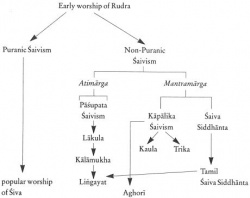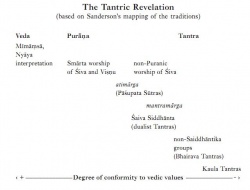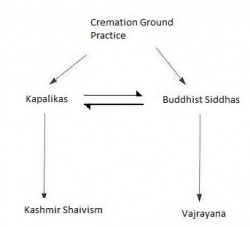Difference between revisions of "Kapalika"
| (2 intermediate revisions by 2 users not shown) | |||
| Line 1: | Line 1: | ||
| + | |||
| + | |||
| + | |||
| + | |||
| + | |||
==[[Kapalika]] and [[Buddhism]]== | ==[[Kapalika]] and [[Buddhism]]== | ||
[[File:DevelopmentofShaivism.jpg|thumb|250px|]] | [[File:DevelopmentofShaivism.jpg|thumb|250px|]] | ||
| − | The Kāpālika [[tradition]] was a non-Puranic, [[tantric]] [[form]] of {{Wiki|Shaivism}} in [[India]], whose members wrote the {{Wiki|Bhairava}} [[Tantras]], including the subdivision called the [[Kaula Tantras]]. These groups are generally known as [[Kāpālikas]], the "[[skull-men]]," so called because, like the [[Lākula Pāsupata]], they carried a [[skull-topped staff]] ([[khatvanga]]) and cranium [[begging bowl]]. Unlike the respectable [[Brahmin]] [[householder]] of the [[Shaiva]] [[Siddhanta]], the [[Kāpālika]] [[ascetic]] imitated his ferocious [[deity]], and covered himself in the ashes from the [[cremation ground]], and propitiated his [[gods]] with the impure {{Wiki|substances}} of {{Wiki|blood}}, meat, [[alcohol]], and {{Wiki|sexual}} fluids from intercourse unconstrained by [[caste]] restrictions. The [[Kāpālikas]] thus flaunted [[impurity]] rules and went against {{Wiki|Vedic}} injunctions. The aim was power through evoking [[deities]], especially [[goddesses]]. | + | The Kāpālika [[tradition]] was a non-Puranic, [[tantric]] [[form]] of {{Wiki|Shaivism}} in [[India]], whose members wrote the {{Wiki|Bhairava}} [[Tantras]], including the subdivision called the [[Kaula Tantras]]. |
| + | |||
| + | These groups are generally known as [[Kāpālikas]], the "[[skull-men]]," so called because, like the [[Lākula Pāsupata]], they carried a [[skull-topped staff]] ([[khatvanga]]) and cranium [[begging bowl]]. | ||
| + | |||
| + | Unlike the respectable [[Brahmin]] [[householder]] of the [[Shaiva]] [[Siddhanta]], the [[Kāpālika]] [[ascetic]] imitated his ferocious [[deity]], | ||
| + | |||
| + | and covered himself in the ashes from the [[cremation ground]], and propitiated his [[gods]] with the impure {{Wiki|substances}} of {{Wiki|blood}}, meat, [[alcohol]], and {{Wiki|sexual}} fluids from intercourse unconstrained by [[caste]] restrictions. | ||
| + | |||
| + | The [[Kāpālikas]] thus flaunted [[impurity]] rules and went against {{Wiki|Vedic}} injunctions. | ||
| + | |||
| + | The aim was power through evoking [[deities]], especially [[goddesses]]. | ||
| + | |||
[[File:ShaivismHistoryMap.jpg|thumb|250px|]] | [[File:ShaivismHistoryMap.jpg|thumb|250px|]] | ||
| − | The [[kapalikas]] may also have been related to the [[Kalamukhas]] ("[[black faces]]") of {{Wiki|medieval}} {{Wiki|South India}} (Lorenzen 1972). Moreover, in {{Wiki|modern}} Tamil Nadu, certain [[Wikipedia:Shaivism|Shaivite]] cults associated with the [[goddess]] [[Angala Parameshwari]], [[Irulappasami]], and [[Sudalai Madan]], are known to practice or have practiced [[ritual]] cannibalism, and to center their secretive [[rituals]] around an [[object]] known as a [[kapparai]] (Tamil "[[skull-bowl]]," derived from the [[Sanskrit]] [[kapala]]), a votive device garlanded with [[flowers]] and sometimes adorned with faces, which is understood to represent the begging-bowl of [[Shiva]] (Meyer 1986). | + | The [[kapalikas]] may also have been related to the [[Kalamukhas]] ("[[black faces]]") of {{Wiki|medieval}} {{Wiki|South India}} (Lorenzen 1972). |
| + | |||
| + | Moreover, in {{Wiki|modern}} [[Tamil Nadu]], certain [[Wikipedia:Shaivism|Shaivite]] cults associated with the [[goddess]] [[Angala Parameshwari]], | ||
| + | |||
| + | [[Irulappasami]], and [[Sudalai Madan]], are known to practice or have practiced [[ritual]] cannibalism, | ||
| + | |||
| + | and to center their secretive [[rituals]] around an [[object]] known as a [[kapparai]] (Tamil "[[skull-bowl]]," derived from the [[Sanskrit]] [[kapala]]), | ||
| + | |||
| + | a votive device garlanded with [[flowers]] and sometimes adorned with faces, which is understood to represent the begging-bowl of [[Shiva]] (Meyer 1986). | ||
| + | |||
| + | |||
=={{Wiki|Literary}} mentions== | =={{Wiki|Literary}} mentions== | ||
| + | |||
[[File:Saiva_Buddhist_relationship4.jpg|thumb|250px|]] | [[File:Saiva_Buddhist_relationship4.jpg|thumb|250px|]] | ||
Dyczkowski (1988: p. 26) holds that Hāla's {{Wiki|Prakrit}} {{Wiki|literature}} poem, the [[Gaha Sattasai]], is one of the first extant {{Wiki|literary}} references to a [[kapalika]]: | Dyczkowski (1988: p. 26) holds that Hāla's {{Wiki|Prakrit}} {{Wiki|literature}} poem, the [[Gaha Sattasai]], is one of the first extant {{Wiki|literary}} references to a [[kapalika]]: | ||
| − | |||
| − | Dyczkowski (1988: p. 26) relates how [[Kṛṣṇa Miśra]] casts the [[character]] of a [[kapalika]] in his play, the [[Prabodhacandrodaya]] and quotes verbatim a source that renders the [[creed]] of this [[character]] into English thus: | + | :::One of the earliest references to a [[Kāpālika]] is found in [[Hāla's]] {{Wiki|Prakrit}} poem, the [[Gāthāsaptaśati]] (third to fifth century A.D.) in a verse in which the poet describes a young {{Wiki|female}} Kāpālikā who besmears herself with ashes from the [[funeral]] pyre of her lover. |
| + | |||
| + | [[Varāhamihira]] (c500-575) refer more than once to the [[Kāpālikas]] thus clearly establishing their [[existence]] in the sixth century. Indeed, from this [[time]] onwards references to [[Kāpālika]] [[ascetics]] become fairly commonplace in [[Sanskrit]] ... | ||
| + | |||
| + | |||
| + | [[Dyczkowski]] (1988: p. 26) relates how [[Kṛṣṇa Miśra]] casts the [[character]] of a [[kapalika]] in his play, the [[Prabodhacandrodaya]] and quotes verbatim a source that renders the [[creed]] of this [[character]] into English thus: | ||
| + | |||
| + | :::"My charming ornaments are made from garlands of [[human]] skulls." says the [[Kāpālika]], "I dwell in the [[cremation ground]] and eat my [[food]] from a [[human]] skull. | ||
| + | |||
| + | I [[view]] the [[world]] alternately as separate from [[God]] ([[Īśvara]]) and one with Him, through the [[eyes]] that are made clear with the ointment of [[yoga]]... | ||
| + | |||
| + | We ([[Kāpālikas]]) offer oblations of [[human]] flesh mixed with {{Wiki|brains}}, entrails and marrow. | ||
| + | |||
| + | We break our fast by drinking [[liquor]] ([[surā]]) from the skull of a [[Brahmin]]. | ||
| + | |||
| + | At that [[time]] the [[god]] [[Mahābhairava]] should be worshiped with [[offerings]] of awe-inspiring [[human]] sacrifices from whose severed throats {{Wiki|blood}} flows in currents. | ||
| + | |||
| + | |||
| + | Beer (2003: p. 102) relates how the [[symbolism]] of the [[khatvanga]] that entered [[esoteric Buddhism]] was a direct borrowing from the [[Wikipedia:Shaivism|Shaivite]] [[kapalikas]] who frequented places of austerity such as [[charnel grounds]] as a [[form]] of [[left-hand path]] ([[Sanskrit]]: [[vamamarga]]) [[left-hand path spiritual practice]] ([[Sanskrit]]: [[sadhana]]): | ||
| − | ::: | + | :::The [[form]] of the [[Buddhist]] [[khatvanga]] derived from the emblematic [[staff]] of the early [[Indian]] [[Wikipedia:Shaivism|Shaivite]] [[yogins]], known as [[kapalikas]] or '[[skull-bearers]]'. |
| + | The [[kapalikas]] were originally miscreants who had been sentenced to a twelve-year term of penance for the [[crime]] of inadvertently killing a [[Brahmin]]. | ||
| + | |||
| + | The penitent was prescribed to dwell in a {{Wiki|forest}} hut, at a desolate crossroads, in a [[charnel ground]], or under a [[tree]]; to live by begging; to practice austerities; and to wear a loin-cloth of hemp, {{Wiki|dog}}, or donkey-skin. | ||
| + | |||
| + | They also had to carry the {{Wiki|emblems}} of a [[human]] skull as an [[alms-bowl]], and the skull of the [[Brahmin]] they had slain mounted upon a wooden [[staff]] as a [[banner]]. | ||
| + | |||
| + | These [[Hindu]] [[kapalika]] [[ascetics]] soon evolved into an extreme outcast sect of the 'left-hand' [[tantric path]] (Skt. [[vamamarga]]) of [[shakti]] or [[goddess]] {{Wiki|worship}}. | ||
| + | |||
| + | The early [[Buddhist tantric yogins]] and [[yoginis]] adopted the same [[goddess]] or [[dakini]] [[attributes]] of the [[kapalikas]]. | ||
| + | |||
| + | These [[attributes]] consisted of; [[bone ornaments]], an [[animal]] {{Wiki|skin}} loincloth, marks of [[human]] ash, a [[skull-cup]], [[damaru]], [[flaying knife]], [[thighbone trumpet]], and the [[skull-topped tantric staff]] or [[khatvanga]]. | ||
| − | |||
| − | |||
Ronald M. Davidson, citing various evidences, disagrees with Alexis Sanderson's [[assertion]] that the [[Kāpālikas]] had a one way influence on the [[Buddhist]] [[yoginī-tantras]] (also known as [[Mother Tantras]]). Davidson concludes: | Ronald M. Davidson, citing various evidences, disagrees with Alexis Sanderson's [[assertion]] that the [[Kāpālikas]] had a one way influence on the [[Buddhist]] [[yoginī-tantras]] (also known as [[Mother Tantras]]). Davidson concludes: | ||
| − | This and other {{Wiki|evidence}} suggests that the Buddhist-Kāpālika connection is more complex than a simple process of [[religious]] imitation and textual appropriation. There can be no question that the [[Buddhist]] [[tantras]] were heavily influenced by Kāpālika and other {{Wiki|Saiva}} movements, but the influence was apparently mutual. Perhaps a more nuanced model would be that the various lines of [[transmission]] were locally flourishing and that in some areas they interacted, while in others they maintained {{Wiki|hostility}}. Thus the influence was both sustained and reciprocal, even in those places where [[Buddhist]] and Kāpālika [[siddhas]] were in extreme antagonism. | + | This and other {{Wiki|evidence}} suggests that the [[Buddhist]]-[[Kāpālika]] connection is more complex than a simple process of [[religious]] imitation and textual appropriation. |
| + | |||
| + | There can be no question that the [[Buddhist]] [[tantras]] were heavily influenced by Kāpālika and other {{Wiki|Saiva}} movements, but the influence was apparently mutual. | ||
| + | |||
| + | Perhaps a more nuanced model would be that the various lines of [[transmission]] were locally flourishing and that in some areas they interacted, while in others they maintained {{Wiki|hostility}}. | ||
| + | |||
| + | Thus the influence was both sustained and reciprocal, even in those places where [[Buddhist]] and [[Kāpālika]] [[siddhas]] were in extreme antagonism. | ||
{{W}} | {{W}} | ||
[[Category:Vajrayana]] | [[Category:Vajrayana]] | ||
[[Category:Tantras]] | [[Category:Tantras]] | ||
Latest revision as of 21:12, 21 November 2015
Kapalika and Buddhism
The Kāpālika tradition was a non-Puranic, tantric form of Shaivism in India, whose members wrote the Bhairava Tantras, including the subdivision called the Kaula Tantras.
These groups are generally known as Kāpālikas, the "skull-men," so called because, like the Lākula Pāsupata, they carried a skull-topped staff (khatvanga) and cranium begging bowl.
Unlike the respectable Brahmin householder of the Shaiva Siddhanta, the Kāpālika ascetic imitated his ferocious deity,
and covered himself in the ashes from the cremation ground, and propitiated his gods with the impure substances of blood, meat, alcohol, and sexual fluids from intercourse unconstrained by caste restrictions.
The Kāpālikas thus flaunted impurity rules and went against Vedic injunctions.
The aim was power through evoking deities, especially goddesses.
The kapalikas may also have been related to the Kalamukhas ("black faces") of medieval South India (Lorenzen 1972).
Moreover, in modern Tamil Nadu, certain Shaivite cults associated with the goddess Angala Parameshwari,
Irulappasami, and Sudalai Madan, are known to practice or have practiced ritual cannibalism,
and to center their secretive rituals around an object known as a kapparai (Tamil "skull-bowl," derived from the Sanskrit kapala),
a votive device garlanded with flowers and sometimes adorned with faces, which is understood to represent the begging-bowl of Shiva (Meyer 1986).
Literary mentions
Dyczkowski (1988: p. 26) holds that Hāla's Prakrit literature poem, the Gaha Sattasai, is one of the first extant literary references to a kapalika:
Varāhamihira (c500-575) refer more than once to the Kāpālikas thus clearly establishing their existence in the sixth century. Indeed, from this time onwards references to Kāpālika ascetics become fairly commonplace in Sanskrit ...
Dyczkowski (1988: p. 26) relates how Kṛṣṇa Miśra casts the character of a kapalika in his play, the Prabodhacandrodaya and quotes verbatim a source that renders the creed of this character into English thus:
- "My charming ornaments are made from garlands of human skulls." says the Kāpālika, "I dwell in the cremation ground and eat my food from a human skull.
I view the world alternately as separate from God (Īśvara) and one with Him, through the eyes that are made clear with the ointment of yoga...
We (Kāpālikas) offer oblations of human flesh mixed with brains, entrails and marrow.
We break our fast by drinking liquor (surā) from the skull of a Brahmin.
At that time the god Mahābhairava should be worshiped with offerings of awe-inspiring human sacrifices from whose severed throats blood flows in currents.
Beer (2003: p. 102) relates how the symbolism of the khatvanga that entered esoteric Buddhism was a direct borrowing from the Shaivite kapalikas who frequented places of austerity such as charnel grounds as a form of left-hand path (Sanskrit: vamamarga) left-hand path spiritual practice (Sanskrit: sadhana):
The kapalikas were originally miscreants who had been sentenced to a twelve-year term of penance for the crime of inadvertently killing a Brahmin.
The penitent was prescribed to dwell in a forest hut, at a desolate crossroads, in a charnel ground, or under a tree; to live by begging; to practice austerities; and to wear a loin-cloth of hemp, dog, or donkey-skin.
They also had to carry the emblems of a human skull as an alms-bowl, and the skull of the Brahmin they had slain mounted upon a wooden staff as a banner.
These Hindu kapalika ascetics soon evolved into an extreme outcast sect of the 'left-hand' tantric path (Skt. vamamarga) of shakti or goddess worship.
The early Buddhist tantric yogins and yoginis adopted the same goddess or dakini attributes of the kapalikas.
These attributes consisted of; bone ornaments, an animal skin loincloth, marks of human ash, a skull-cup, damaru, flaying knife, thighbone trumpet, and the skull-topped tantric staff or khatvanga.
Ronald M. Davidson, citing various evidences, disagrees with Alexis Sanderson's assertion that the Kāpālikas had a one way influence on the Buddhist yoginī-tantras (also known as Mother Tantras). Davidson concludes:
This and other evidence suggests that the Buddhist-Kāpālika connection is more complex than a simple process of religious imitation and textual appropriation.
There can be no question that the Buddhist tantras were heavily influenced by Kāpālika and other Saiva movements, but the influence was apparently mutual.
Perhaps a more nuanced model would be that the various lines of transmission were locally flourishing and that in some areas they interacted, while in others they maintained hostility.
Thus the influence was both sustained and reciprocal, even in those places where Buddhist and Kāpālika siddhas were in extreme antagonism.


